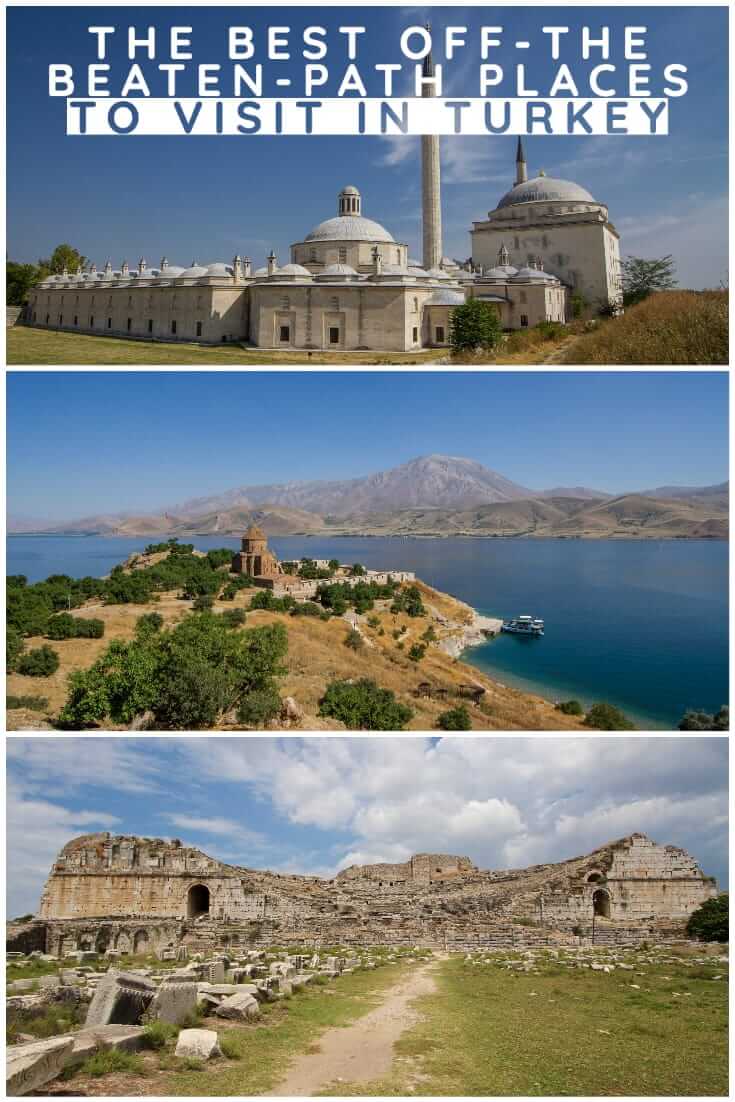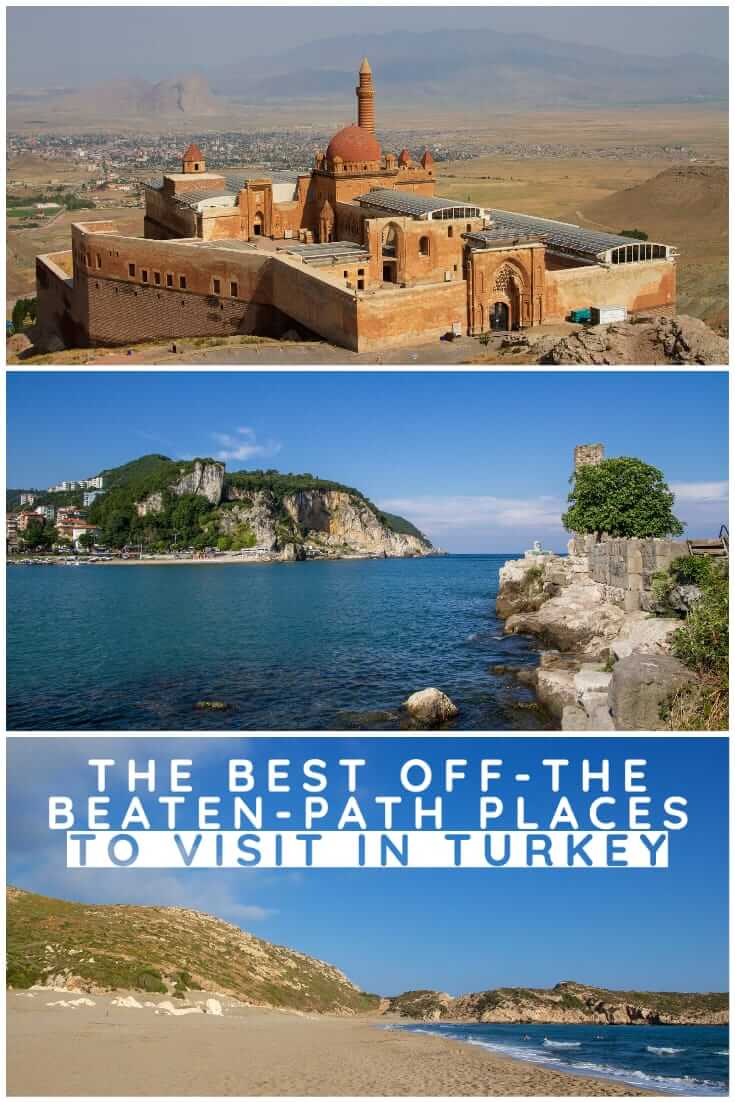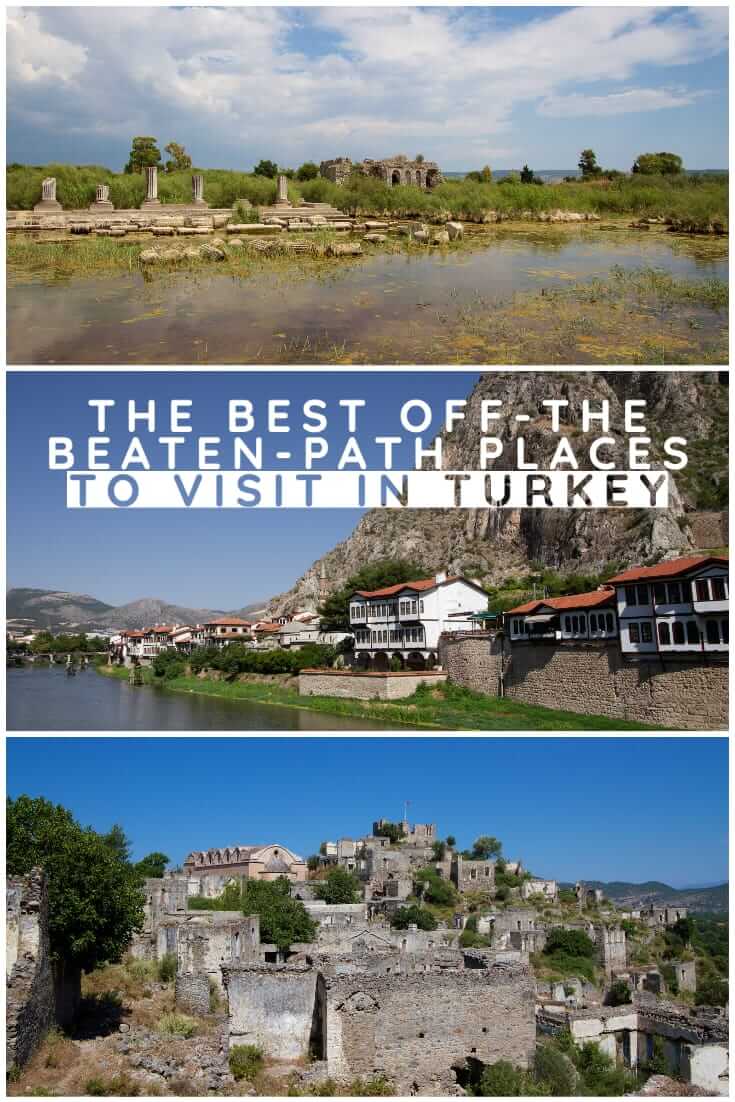A guide to where you should go in Turkey once you’ve seen Istanbul and Cappadocia
Turkey is one of the most diverse countries on the planet. We love visiting Turkey and have been there many times throughout our travelling years. A couple of years ago, we spent two months in the height of the summer season slowly making our way east through Turkey to the Caucasus. It was a fantastic trip, which took us from Istanbul down the Aegean and Mediterranean coasts to Antalya and then inland to Cappadocia and eventually through the predominately Kurdish-speaking eastern region of the country. We still consider it to be one of the best journeys we have ever done. Since then, we have also travelled along the country’s Black Sea Coast and visited the area northwest of Istanbul en route to neighbouring Bulgaria.
For the record, we’re not dismissing Istanbul and Cappadocia or saying that they should be left off your Turkey itinerary. We’ve spent more than our fair share of time exploring Istanbul – it’s a glorious city with a vast amount going for it and during our two-month sojourn mentioned above, we stopped for a full week in Cappadocia and had a great time undertaking daily hikes through its otherworldly scenery.
But, and you can probably guess what I’m going to say here, there is so much more to Turkey beyond these two destinations and this post aims to focus on some of the other wonderful places to visit in Turkey.
Some of the places mentioned below have a lot of copy attached to them, while others only involve a few paragraphs or so but each one is worth visiting and that’s why I’ve included them on the list. The map shows the locations in case you want to plan an off-the-beaten-path Turkey trip.
The best places to visit in Turkey after Istanbul and Cappadocia
CONTENTS (Click to expand)
Van
I’m going to start way out in Turkey’s eastern reaches. Located on the eastern shore of Lake Van, the city of Van has been a decent-sized settlement since the first millennium BCE and was capital of Urartu (the Kingdom of Van) from its rise to power in the middle of the 9th century BCE until its eventual demise in the 6th century BCE when it was conquered by ancient Iranians known as Medes. The majority of its 300,00-plus population are Kurdish.
The city itself is a bit scruffy and nondescript but it is its proximity to some magnificent sights that makes it such an interesting place to visit.
Not to be missed sights in and around Van
Some 1,600kms east of Istanbul, Lake Van Is one of the primary reasons to come to this region of Turkey. Encircled by snowcapped peaks, this inland sea is Turkey’s greatest body of water and also happens to be one of the greatest endorheic (no natural outflow) lakes on the planet. Once one of the three great lakes of the Armenian Kingdom, it is said that those who once lived around Lake Van would say “Van in this life, paradise in the next” in reference to the region’s magnificence and the fertile lands that surround it.
The jewel in the crown is Akdamar Island, one of four islands in the lake, which is topped with the photogenic 10th-century Armenian Church of the Holy Cross. Looking down onto the church with the lake in the background is the classic Lake Van view. Although, if you spend any amount of time circumnavigating the lake, which we would highly recommend, by the way, you will be spoilt for choice when it comes to spectacular vistas and this will be just one of many.
Akdamar Island can easily be visited by dolmus (fixed-route minivan) from either Van or Tatvan, which is the other major city located on the lake. We decided to visit en route between the two cities. The dolmus driver dropped us at Akdamar harbour, where we left our bags in the office while we went out to the island and back. Boats to the island leave when full (approximately 15 people), which is often in the summertime but less frequent or only on a charter basis outside this period.
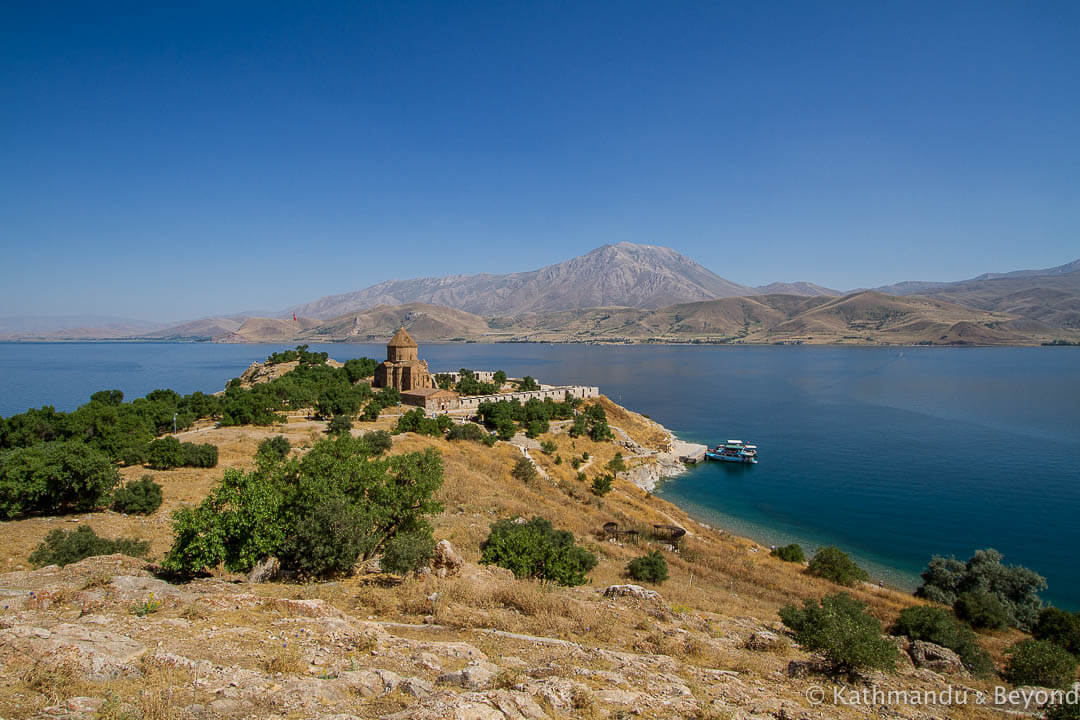
Akdamar Island, Lake Van
Van’s sprawling citadel dates back to the Kingdom of Urartu. The place is huge and it takes a good couple of hours to explore its ramparts. The ruins that can be seen from the castle’s northern walls are of Tushpa, the original capital of Urartu which later became known as Van.
As an aside and a bit of a reminisce for my good self, I first visited Van in 1993 when the terrorist group, the Kurdistan Workers’ Party (more commonly referred to as the PKK) were fairly active in the region and the British Foreign Office was advising against all but essential travel to Eastern Turkey. I went with my then-girlfriend at the time, Sam, and we met a couple of guys at the castle who said they would drive is back to our hotel. We accepted but they decided to take us on a detour to a scenic spot somewhere in the opposite direction to the city. It was a bit nervy at the time and we both got a little worried that we were about to get kidnapped, which was a favoured tactic of the PKK. The guys turned out to be genuine and after about an hour or so of looking at the view and listening to loud Turkish music, they dropped us off at our hotel and said goodbye. There was a curfew in Van at the time and in the middle of the night, the deadly silence was broken by a loud bang that sounded like a gunshot. It instantly woke both of us and at the behest of Sam, I went to the window of our hotel room to see what it was. I could see that a large piece of corrugated iron had fallen over and I came back to bed chuckling to myself. This was more out of relief than anything else but Sam thought I found it funny that we had just had the living daylights scared out of us and, without warning, smacked me in the kisser and told in no uncertain terms that we were getting the hell out of the city first thing in the morning, which we did do!
Van Castle is 4kms west of the city centre. It can be reached by dolmus or on foot.
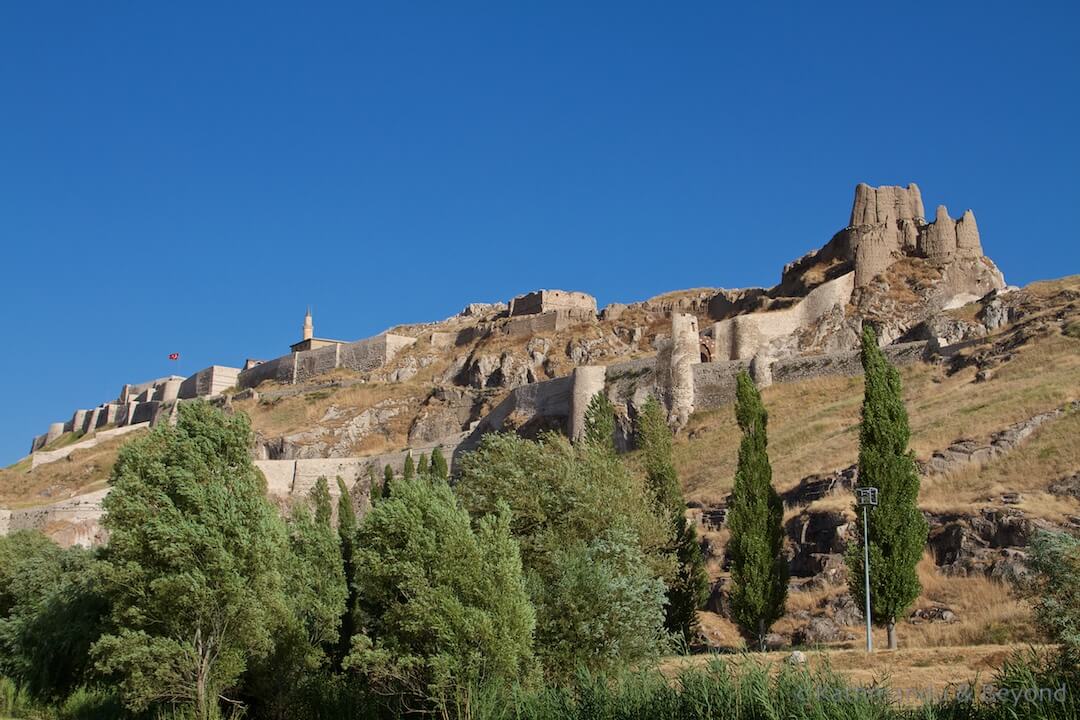
Van Citadel
You’ll need to bring your imagination to Cavustepe as there isn’t a whole lot to see but this ancient site was once home to a fortress-palace called Sardurihinilli, which was used by the Urartian kings during the 8th century BCE. If what is left of the palace doesn’t inspire you, the fantastic views across the Eastern Anatolian plains should do the job.
Cavustepe is 25kms southeast of Van and can be reached by dolmus. Take any one heading in the direction of Baskale or Yuksekova.
Hosap Castle is a beast of a fortress that completely overshadows the titchy village of Guzelsu (previously Hosap), over which it looms. Most of what can be seen today was constructed at the behest of a local Mahmudi (Ottoman-Kurdish tribe) ruler named Süleyman Bey in the middle of the 17th century. In Kurdish, the fortification is called Kela Xosabe which translates as Beautiful Water Castle.
Hosap Castle is 50kms from Van in the same direction as Cavustepe and both places can be combined in the same visit. If transport is a bit sparse between the two then you might want to try and hitch, which is what we did and worked for us.
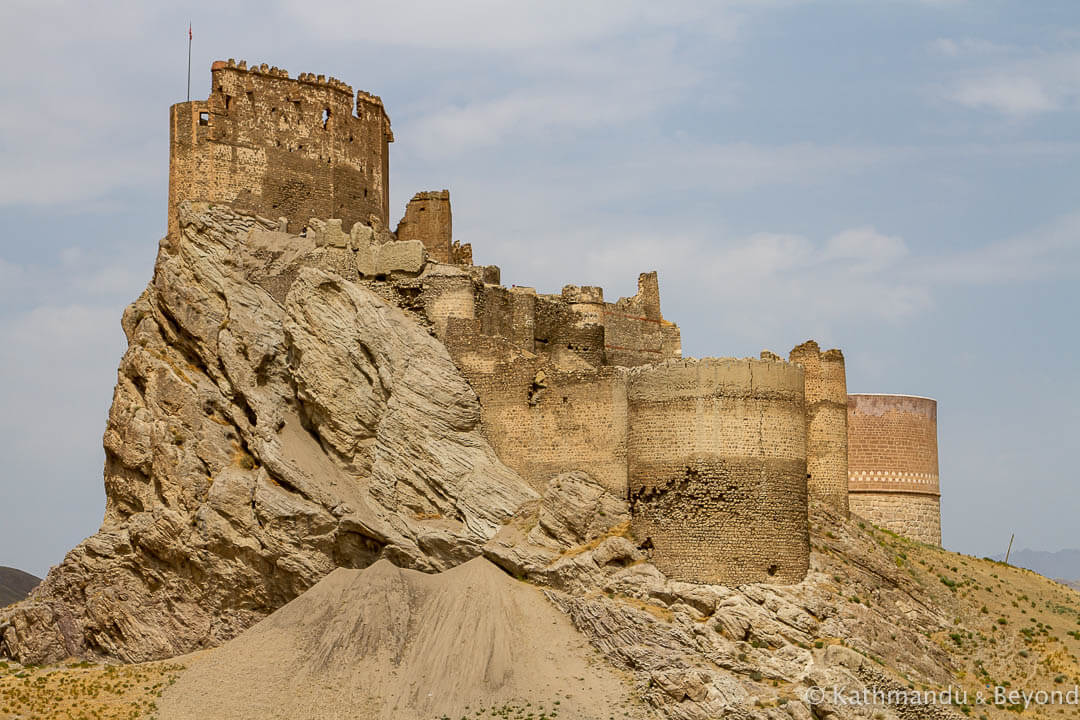
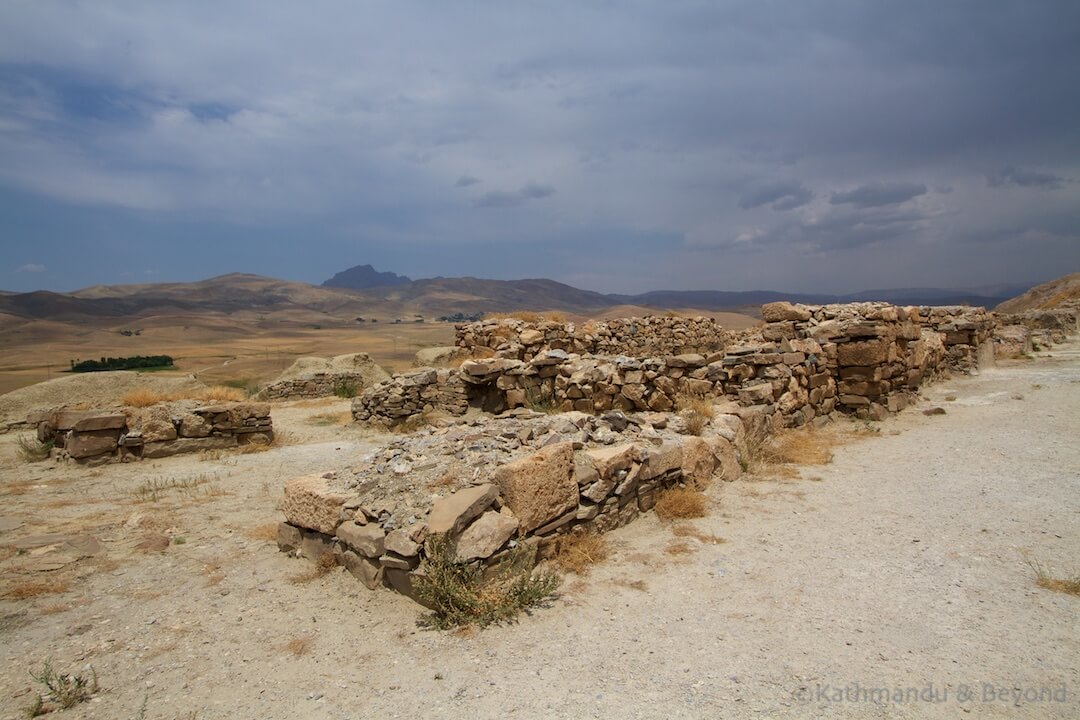
Hosap Castle (right) and Cavustepe (left)
Safranbolu
Safranbolu old town, which is known as Çarşı, might be a tad touristy in places but don’t let that put you off visiting. This UNESCO World Heritage-listed city has one of the best-preserved Ottoman quarters in all Turkey and is a superb place to visit for a day or two.
Not to be missed sights in Safranbolu
Located in the country’s Black Sea region, but not on the coast, Safranbolu is all about ambling along cobblestone streets, stopping for a tea in a former caravanserai and spending the night in one of the many Ottoman-period mansions that have been tastefully converted into boutique hotels.
The district directly south of the heart of the Çarşı is a good area to explore because it sees fewer tourists and most of the houses are still inhabited by the town’s residents. It is also worth tackling the steep climb up onto the plateau housing the new town. The view back down onto the Çarşı is magnificent.
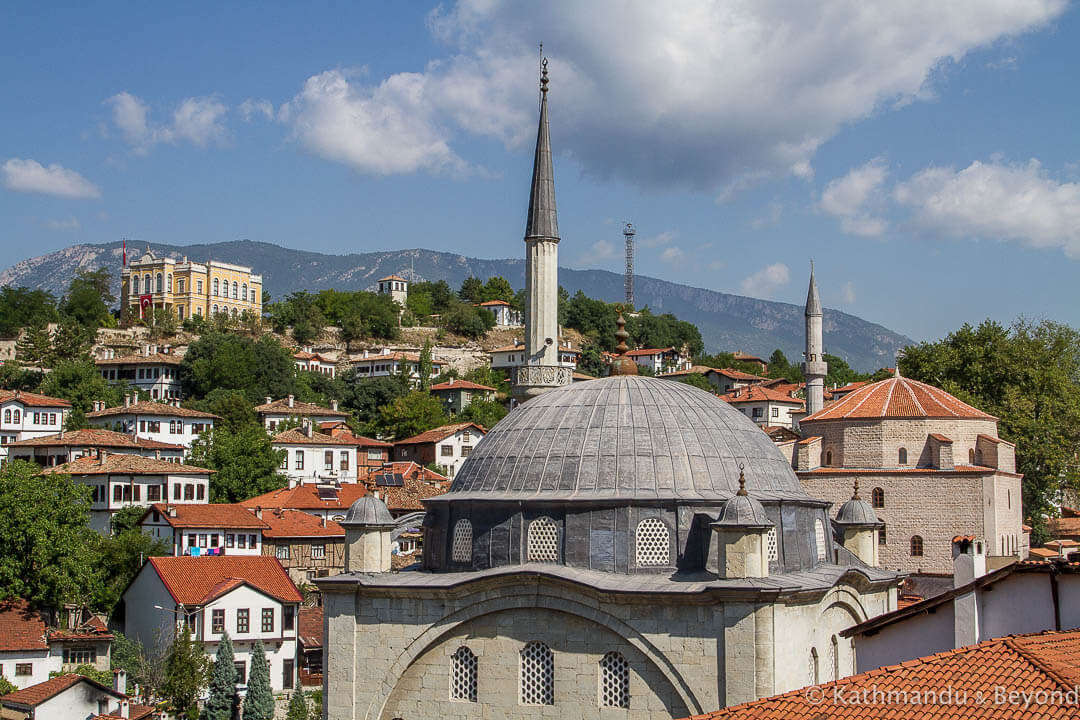
Safranbolu
Bergama/Pergamon
This small city in western Turkey’s İzmir Province is a nice place to kick-back for a couple of days but the real reason it should be on any visitor’s radar is that it is home to the formidable ancient ruins of Pergamon. We have seen more than a dozen classical sites in this western/Aegean part of the country and Pergamon remained one of the most impressive.
Not to be missed in Pergamon
Once a rich and powerful Greek city, Pergamon is another of Turkey’s eighteen UNESCO World Heritage sites. Whilst you’re likely to see all of these places while exploring anyway, highlights at Pergamon include the 335-metre-high mountainside Acropolis, the Temple of Trajan and the Upper Gymnasium. If you begin at the top, you can walk down to the gymnasium and the Lower Agora and from this point head back to the centre of Bergama.
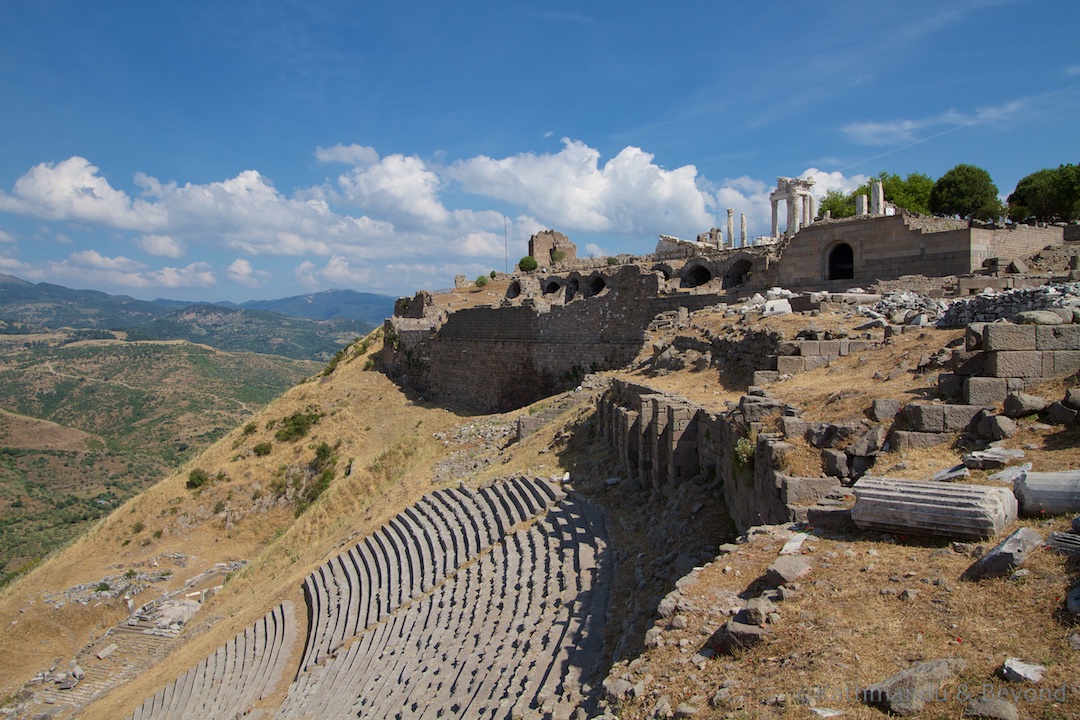
Pergamon
Guzelyurt
Part of the historical region of Cappadocia, the small town of Guzelyurt is more low key when compared to more popular bases in the region, such as Goreme and Uchisar. Like the two towns just mentioned, the reasons to visit Guzelyurt include sublime scenery, rock-hewn churches and the opportunity to enjoy a spot of gentle hiking.
Although Guzelyurt sees far fewer visitors and offers a more peaceful experience, the scenery and sights around Goreme, 80kms to the northeast, are more impressive. If you have the time or inclination stay in both, but if you have to pick one over the other, I would choose Goreme. It’s worth pointing out that if you are keen to stay in a cave hotel, which is one of Cappadocia’s de rigueur things to do, then they are more affordable in Guzelyurt.
Not to be missed sights in and around Guzelyurt
Monastery Valley is a 4.5km rift full of rock-cut churches and numerous cave dwellings. This is the best place to go for a hike and there are also great panoramic vistas from some of the elevated points along its route. Near the ticket booth is a restored underground city and not far from this point is the Büyük Kilise Camii (Great Church Mosque) and Sivişli Kilisesi (Sivişli Church), where parts of the original frescoes can still be seen.
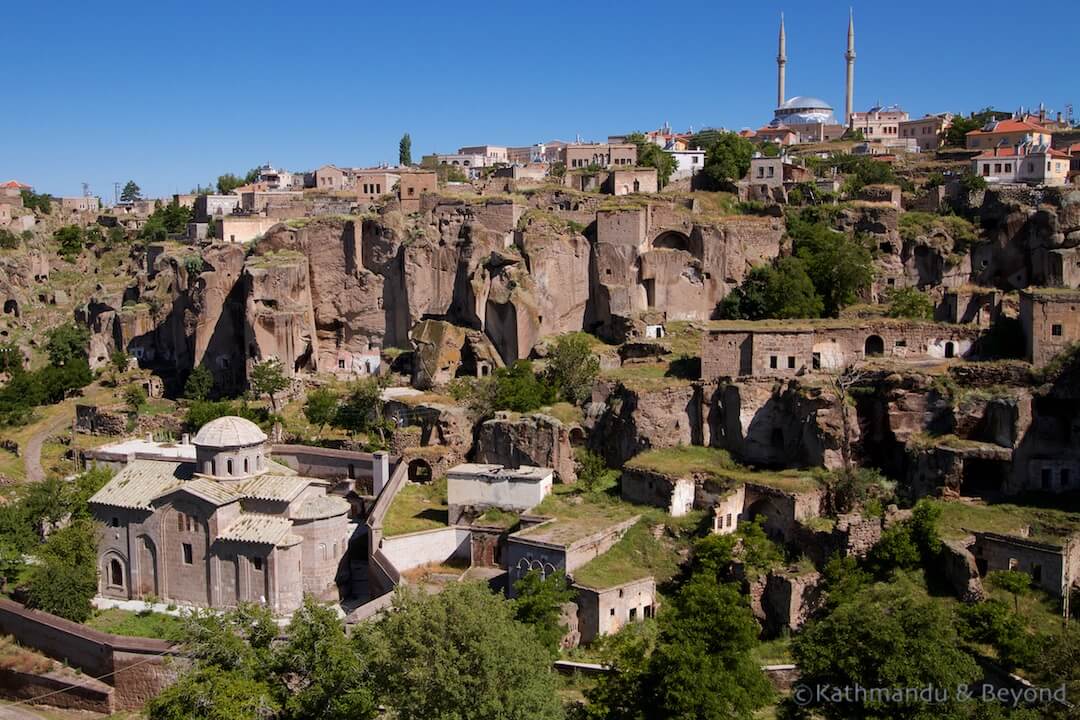
Guzelyurt
Ani
A former Armenian capital and still very much a contentious issue, Ani is a remarkable series of ruins atop a desolate plateau that overlooks the (closed) Turkish-Armenian border.
With a population of almost 100,000 people by the beginning of the 11th century, Ani was one of the largest cities in the world at its peak. A cultural hub as well as an important centre for commerce, the ‘City of 1,001 Churches’, as it was known, began to decline after it was sacked by the Mongols in 1236. A devastating earthquake followed in 1319, from which the city never fully recovered, and by the middle of the 17th century the metropolis was all but forgotten.
Not to be missed sights at Ani
All of it! Actually, it’s difficult to miss any of the remaining structures because each one stands in splendid isolation and can be spotted a mile away. The Church of St Gregory, which still has decorative frescos adorning its interior walls, is probably Ani’s most iconic structure but what’s left of the formidable city walls is also an impressive sight. And you won’t want to miss the lone Menucer Camii (mosque), which was constructed by the Shaddadids, a Muslim dynasty of Kurdish descent, in the early years of the 11th century. The mosque sits precariously on the edge of a ravine and the views from this point, especially if the spiral staircase leading to the top of the minaret is open, are outstanding.
Often dubbed a ‘ghost city’, it is likely that you will be one of just a handful of visitors at Ani due to its remote location. Situated 45kms east of Kars, the only way to get to there is by private car/taxi. In their latest (2017) Turkey guide, Lonely Planet recommends the services of driver-guide, Celil Ersözoğlu. We visited the site with him and although he was an affable guy and his English was excellent, we found him to be a bit pushy and overpriced before agreeing to use his services. Minutes after we had checked into our hotel in Kars, he turned up and offered to take us to Ani the following day. I can’t remember exactly what he quoted but we obtained quotes from a couple of taxi drivers hanging around the bus station and the price they told us was lower. We ended up going with Celil Ersözoğlu because he dropped his original price by a considerable amount as he had already promised two other tourists that there would be four of us and he needed us to make up the numbers. We had three hours to explore the ruins, which was ample time.
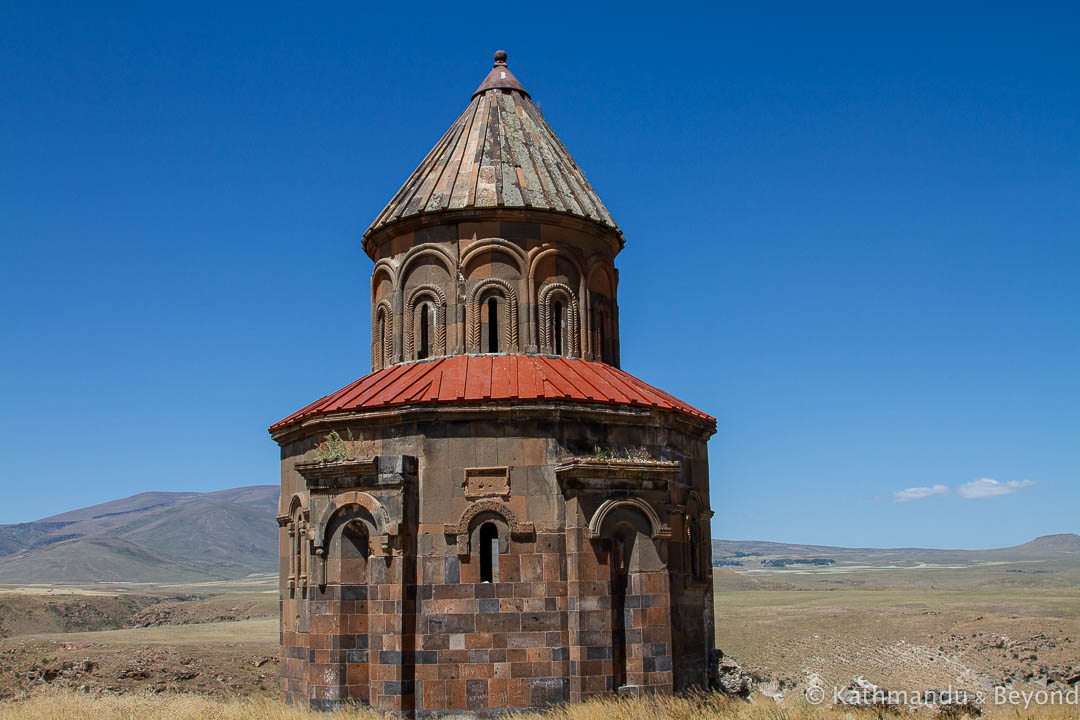
Church of St Gregory (Abughamrentz), Ani
Amasra
Located approximately 430kms east of Istanbul, Amasra is one of the most appealing towns on Turkey’s Black Sea Coast. The heart of the town is positioned on a peninsula with a bay on either side that, in turn, extends out onto a rocky island that is only accessible via a bridge dating from Roman times. It’s these factors that give Amasra its attractiveness and the reason why it is popular with holidaying Turks during the summer season.
You’re unlikely to see many overseas visitors in Amasra and, although some of the Turkish tourists are here to explore the town, most, from what we witnessed, come to enjoy the crowded local beach and to frolic in the sea. Amasra has an abundance of places to stay and there are many restaurants, as well as a few bars near both of the town’s harbours. But, it’s all lowkey stuff and, although it doesn’t sound like I’m really selling it, we enjoyed our time in Amasra and ended up staying a couple of days longer than we intended because of this reason.
Not to be missed sights in and around Amasra
Wandering around the backstreets and admiring the view from both sides of the Roman bridge are the main activities in Amasra if you are not here for the beach. The island is also nice for a stroll and for a more distant perspective of the town itself, heading out to sea on one of the numerous boat trips offered down at Büyük Liman (Big Harbour) is a worthwhile, if rather touristic, experience.
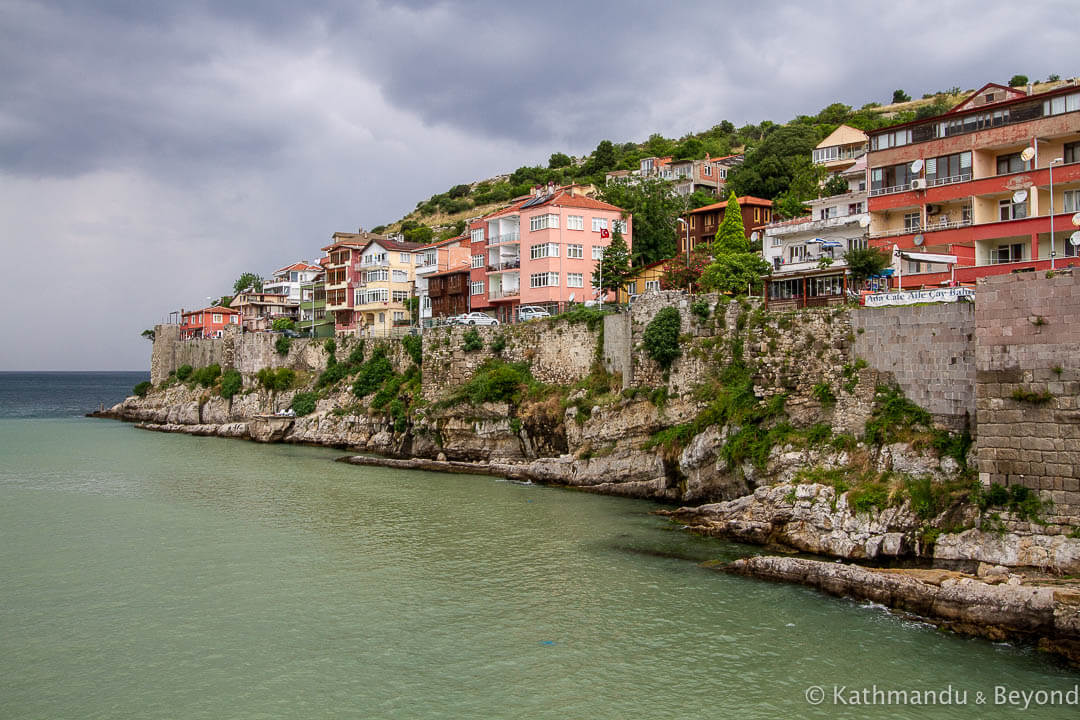
Amasra
Edirne
Founded by the Roman emperor, Hadrian, when the area was part of ancient Thrace, the northwestern city of Edirne is an accessible and extremely interesting place in which to spend a day or two. Edirne is very close to the Bulgarian border (and the Greek one too) and is an ideal place to break the journey if you are travelling between Istanbul and Sofia.
Not to be missed sights in and around Edirne
The most famous event to take place in Edirne is the popular oil-wrestling tournament called Kirkpinar. Dating back to the middle of the 14th century, the competition takes place every year in either late June or early July. It draws a massive crowd and is probably the only time of year that it is necessary to pre-book accommodation and public transport some way in advance.
If you can’t make the tournament dates, Edirne is still worth spending time in. The impressive, and UNESCO-listed, Selimiye Mosque is a must-see as is the complex of Sultan Bayezid II Mosque and Health Museum, which is a 2km walk northwest of the city centre. Back in town, the covered bazaar is refreshingly hassle-free and we can also recommend wandering around the kaleici (old town) for a bit. This is also a good place to try the city’s signature dish – thinly sliced and deep-fried calf’s liver which is served with fried red chillis and known locally as ciger tava.
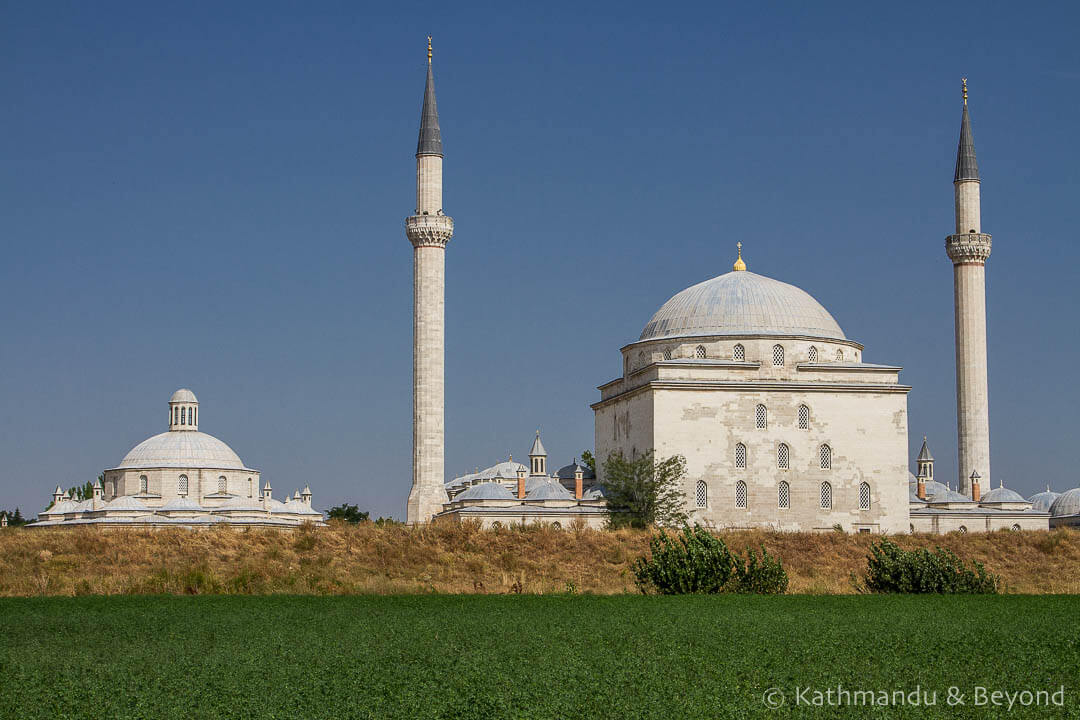
Sultan Bayezid II Mosque and Health Museum, Edirne
Konya
One of the holiest Muslim cites in Turkey, Konya is home to the renowned whirling dervish, a trance-like-dance performed by the Sufi Mevlevi Order. A former Seljuk capital (1097-1243), today Konya is a big city and the seventh-most-populous metropolis in the country. Once you are in the centre of it, however, everything worth seeing is within easy walking distance and Konya is one of the most appealing cities we have visited in Turkey.
Not to be missed sights in and around Konya
Konya’s undisputed highlight, even more so than seeing a performance of the Whirling Dervishes, in my opinion, is the Mevlâna Museum. Giving it the title of ‘museum’ is a tad misleading, however. The Mevlâna is a former dervish lodge and the location of the mausoleum of Jalaluddin Muhammad Balkhi Rumi, a 13th century Sufi mystic of Persian descent more simply known as Rumi. The Mevlâna Order was founded by followers of Rumi and because his influence transcends ethnic divisions, the museum receives pilgrims and visitors from many corners of the Islamic world. Non-Muslims, appropriately dressed, of course, are allowed to enter and inside the atmosphere is a serene and quite magical one.
Because Konya is an important religious city, there are other mosques in the vicinity that are worth visiting, including Serafettin Mosque, Kapu Mosque and Selimiye Mosque, the last of which is on the same square as the Mevlâna Museum. There are also several conventional museums in Konya, of which the Tile Museum is supposed to be one of the best.
If you want to witness a display of the Whirling Dervishes, then you will have to plan your visit to Konya around a Saturday night as this is the only day there is a public performance. It takes place at the Mevlana Cultural Centre, which is located approximately 1km from the Mevlâna Museum. The show starts at 7pm and is free of charge. From our experience, there is no need to get there especially early or try and get tickets in advance. Call me a heathen, but the performance does go on a bit and is rather repetitive, in my opinion!
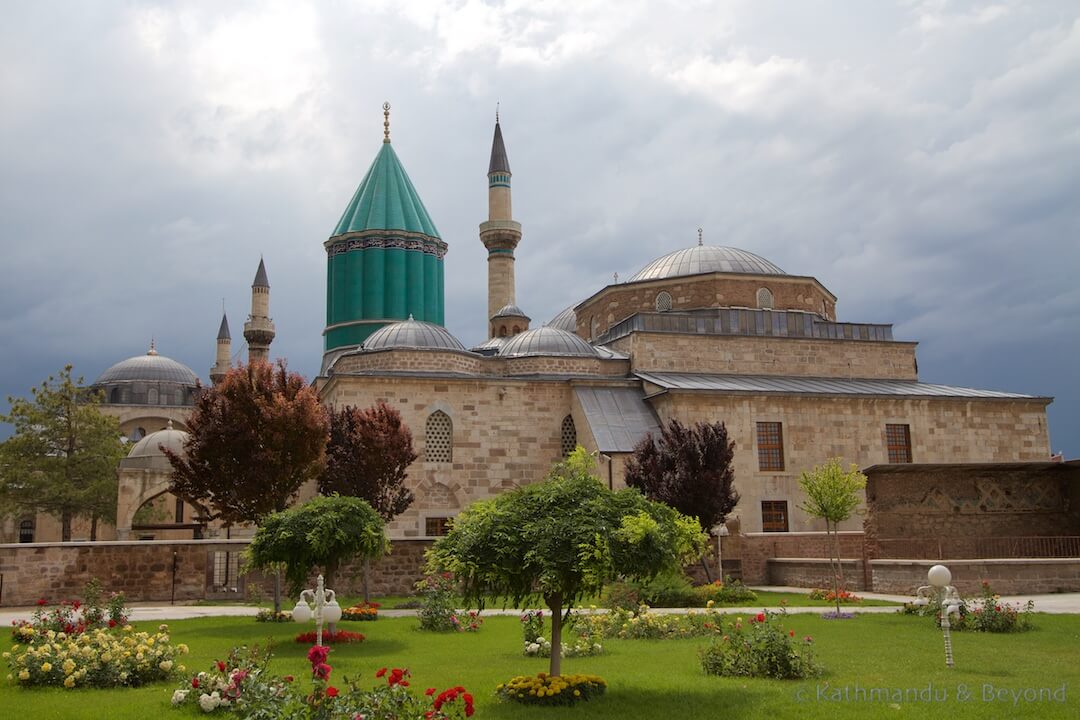
Mevlâna Museum, Konya
Dogubayazit
Nicknamed ‘doggy biscuit’ by the original 1970s overlanders, Dogubayazit is the last sizeable (Kurdish) town in eastern Turkey before hitting the border with both Iran and Armenia. Because of its location, it has a real frontier feel to it and if you do meet any other foreigners whilst there, they are more than likely on their way to, or have just arrived from Iran (the border between Turkey and Armenia is not open). I’ve now been to Dogubayazit four times and even though the town itself is rather charmless and a bit rough and ready, I kind of like the place.
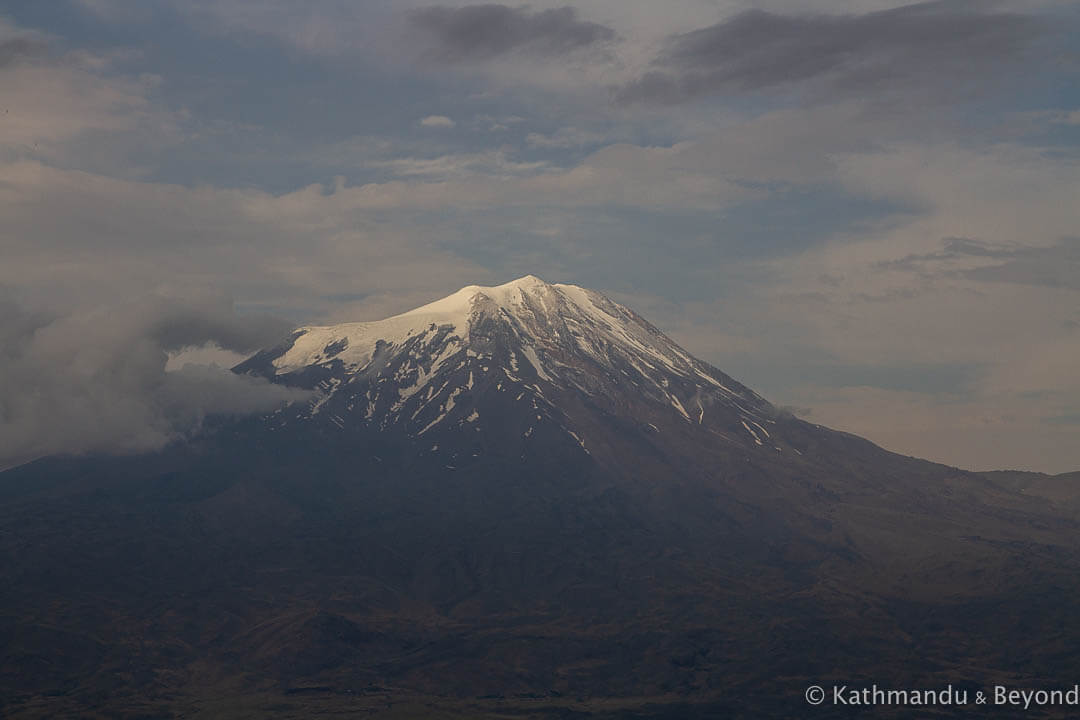
Mount Ararat
Not to be missed sights in and around Dogubayazit
From a point of view of actual sights, there are two reasons to spend time in Dogubayazit. The first of these is the town’s proximity to the snow-capped peaks of Mount Ararat. Dogubayazit is only 15kms southwest of the biblical mountain and when all, or part of the massif decides to poke its head out of the clouds, the view is stupendous. You can see Mount Ararat from the town itself but for a superior view, you are better off walking in the direction of the mountain, through the cluster of houses on the town’s periphery, until you reach the barren grassland that eventually leads to the base of the mountain.
If there is no escalated tension between Turkey and Armenia and the area around the mountain hasn’t been declared a restricted military zone, it is possible to climb Mt Ararat with the right permits and the services of a reputable climbing/trekking agency. The demanding trek takes five days and you’ll need to be comfortable with using crampons as there are snow and ice on the higher reaches of the mountain all year round.
The other landmark not to be missed in the vicinity of Dogubayazit is the ishak Pasa Palace and nearby Beyazıt Mosque. Located on a plateau 6kms southeast of town and reached via a series of switchbacks, the ishak Pasa Palace is one of Turkey’s most iconic sights and often features in tourist board material promoting the country. It’s hard to beat the view, although unfortunately there isn’t one of Mount Ararat from this point, and when you’re done there is even more scenery to discover further up the mountainside, including the remains of an old castle.
Dolmus run semi-regularly from the town up to the ishak Pasa Palace. If there isn’t one readily available for the journey down, start walking and someone will soon give you a lift.
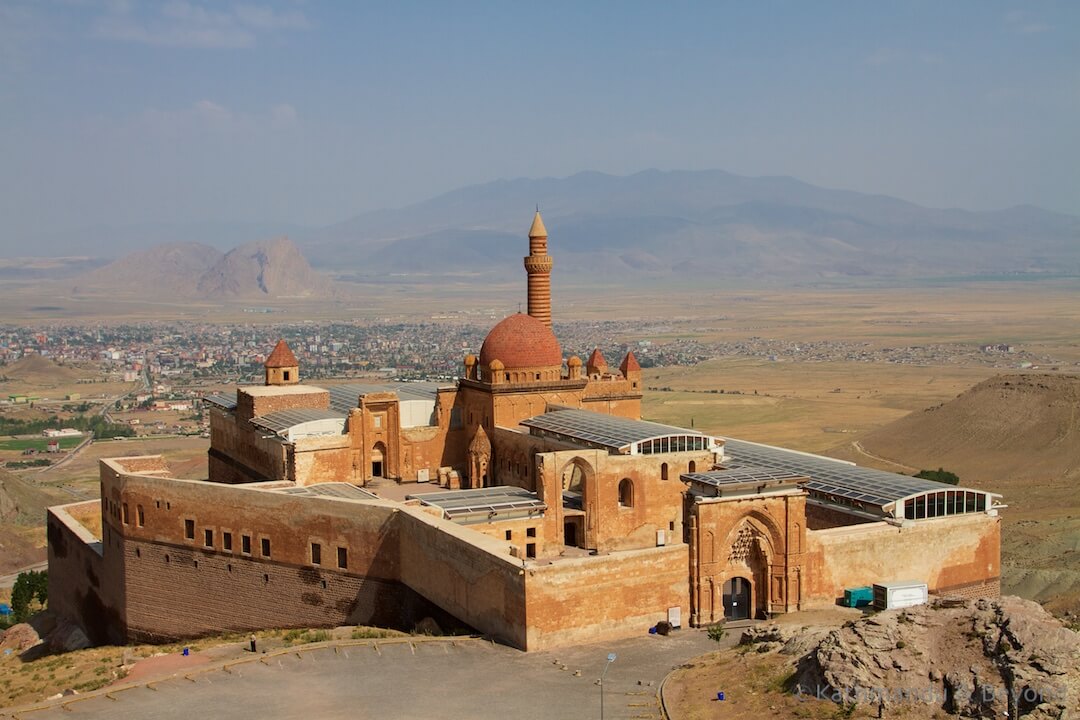
ishak Pasa Palace, Dogubayazit
Ankara
In all the times we have been to Turkey, we’ve always avoided spending time in Ankara. We finally visited in the summer of 2018 and straightaway wondered why we had avoided the city for so long. Overshadowed by Istanbul, Lonely Planet is correct in stating that drawing comparisons between the two cities is a pointless exercise. Ankara doesn’t have any of the Ottoman grandeur or other renowned sights that you’ll find in abundance in Istanbul. But, on the other hand, Ankara has none of the pushiness that you sometimes get in Istanbul and most importantly, it has a fraction of the tourists. We spent two full days looking around the Turkish capital and left wishing we’d had a couple more. The reason for this was not so much because there were other places we wanted to visit but more down to the fact that the city has a nice feel to it and there were plenty of appealing cafes and green spaces in which to spend time and take in the goings-on.
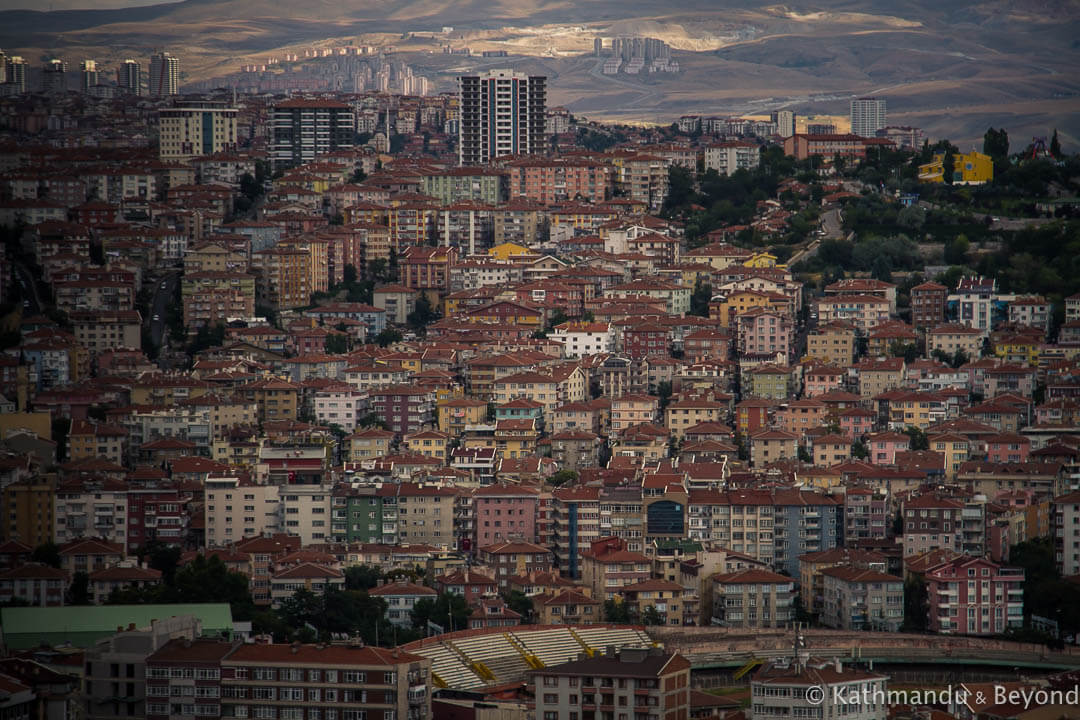
Ankara
Not to be missed sights in and around Ankara
Not to be missed is the Anıtkabir mausoleum of Mustafa Kemal Atatürk, founder of modern-day Turkey. Work on the structure started in 1944 (Atatürk died in 1938) and was completed in 1953. Everything about it, from the twelve pairs of stone lions that line the approach to the vast Ceremonial Plaza and the tomb itself, is monumental and well worth seeing. The complex is away from the city centre but can easily be reached using Ankara’s metro system. It’s free to enter but you will be subject to a series of security checks.
Back in the centre of the city, the medieval-era citadel is a pleasant place for a stroll. The area used to be very run-down but it has been given a makeover in recent years. There are plenty of shops selling souvenir-style tat and if there is a touristy part of the city, then this is it. It’s worth climbing to the top of the ramparts for a good view down onto the old quarter.
Not surprisingly, given it is the country’s capital, there are some impressive mosques in Ankara. One that caught our eye was the recently constructed (2017) Melike Hatun Mosque in the old quarter. We also went to see Kocatepe Mosque, which is also fairly modern (1987) and the largest mosque in the city. It’s interior, with numerous stained-glass windows was especially impressive. For a break from the urban sprawl, the centrally-located Gençlik (Youth) Park is a good place to delve into and the market area in the old town is also good for a wander.
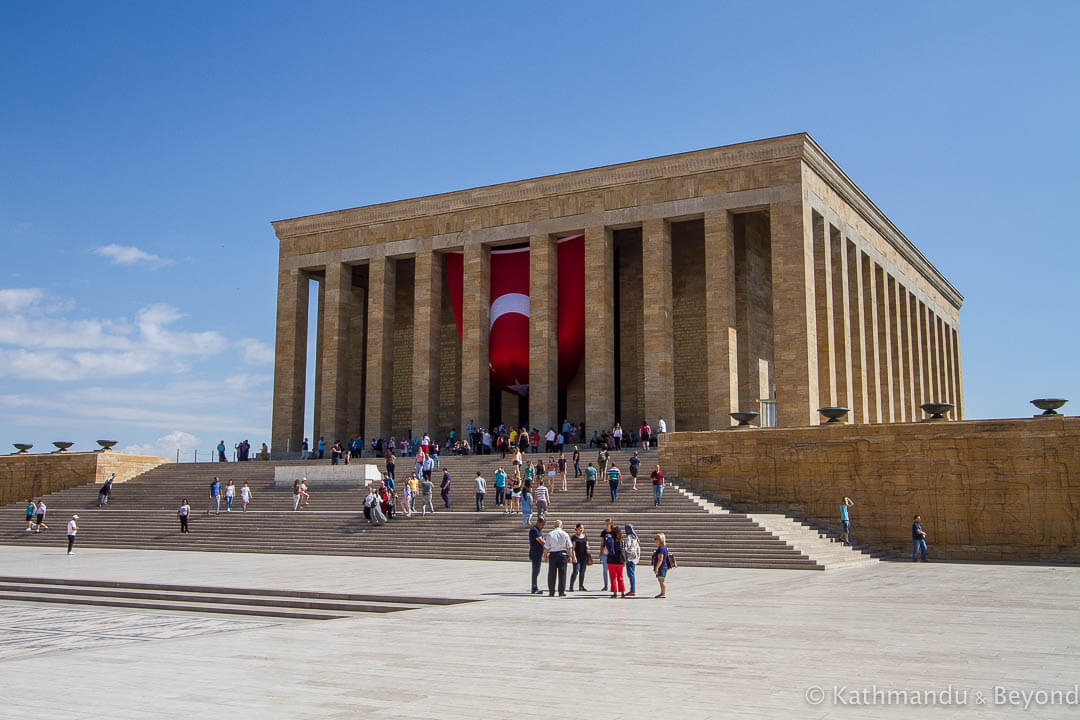
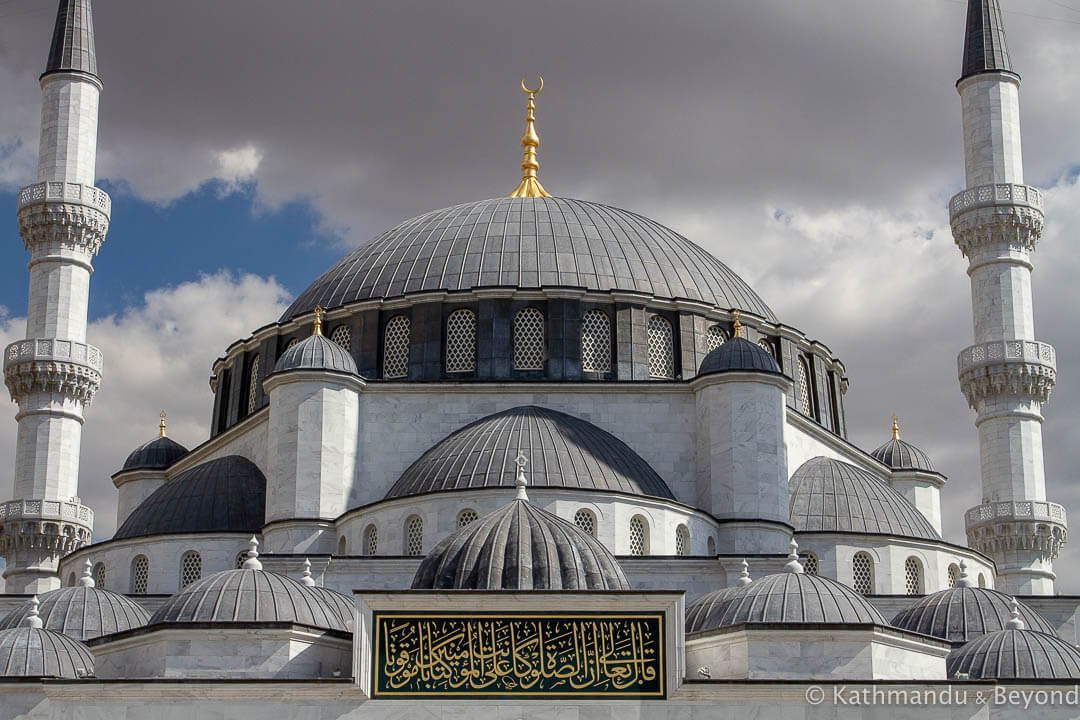
Ankara: Anıtkabir (right) Melike Hatun Mosque (right)
Amasya
Amasya isn’t a big town but what there is of it is very picturesque. About 350km northeast of Ankara in the direction of the Black Sea, Amasya is split in two by the Yeşilırmak River, the north bank of which is dominated by half-timbered Ottoman houses. Many of these Ottoman-era buildings have been converted into boutique hotels, some of which are very reasonably priced. Adding decent cafes and restaurants, on both banks of the river, and an all-round relaxed atmosphere into the mix makes Amasya a great place in which to slow down for a few days or more.
Not to be missed sights in and around Amasya
The main activity in Amasya is wandering through the back streets on the north side of the Yeşilırmak River and along the riverside path on the south side. The only thing that uses any real energy is visiting the Tombs of the Pontic Kings, a series of ancient burial chambers cut into the mountain that looms above the town. Although, even with visiting the tombs there is good news on the being lazy-front as they aren’t that impressive close-up and are best viewed looking up, and from a distance! You will get a great view back down onto Amasya, however, if you do make the effort to walk up to them.
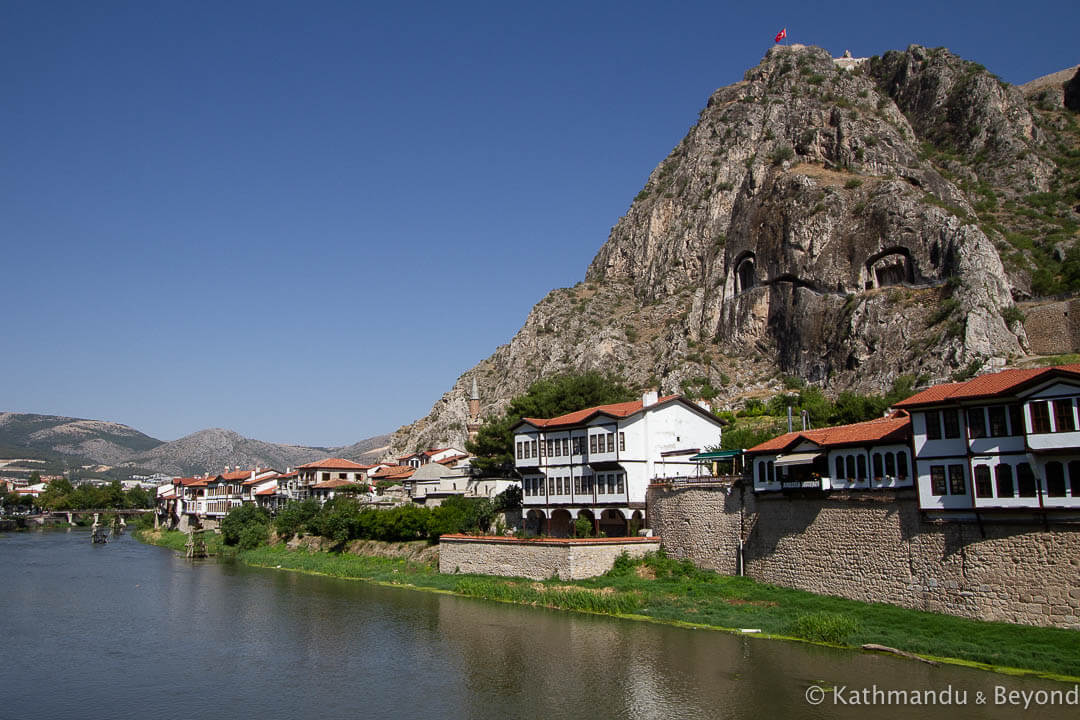
Amasya
Hattusa
The evocative Hittite Kingdom of Hattusa is a worthy stopover if travelling through Turkey’s central region. This off-the-beaten-track series of UNESCO-listed ruins required a bit of effort to reach on public transport and, once there, involves several kilometres of walking to fully appreciate them. But, if you are OK with accepting the odd lift from passing traffic you shouldn’t have too much trouble getting to the small town of Bogazkale, the base for visiting Hattusa, or around the site’s 6km circuit itself.
Not to be missed sights in and around Hattusa
The first thing you see as you approach the ticket office for Hattusa is the reconstructed City Walls. Not especially authentic, it’s not a great first impression but, don’t worry, it gets better thereafter. Soon after the ticket office is the Great Temple (Büyük Mabet) and from this point onwards the road climbs quite steeply to the Lion Gate (Aslanlı Kapı), which is one of Hattusa’s most recognisable landmarks. The positive about ascending is that the views become better and better at every turn. In fact, I would even go as far as to say that the craggy mountain scenery and panoramic vistas of what remains of the former Hittite capital are on an equal par with the actual site itself.
There is a second part to the Hittite complex that shouldn’t be missed and that is the rock-cut caves at nearby Yazılıkaya. The holiest religious sanctuary in the empire, Yazılıkaya is fascinating because several sections of the ornate relief that would have once adorned much of the sanctum is still visible and relatively well preserved given its age (circa 13th century BCE) and exposure to the elements.
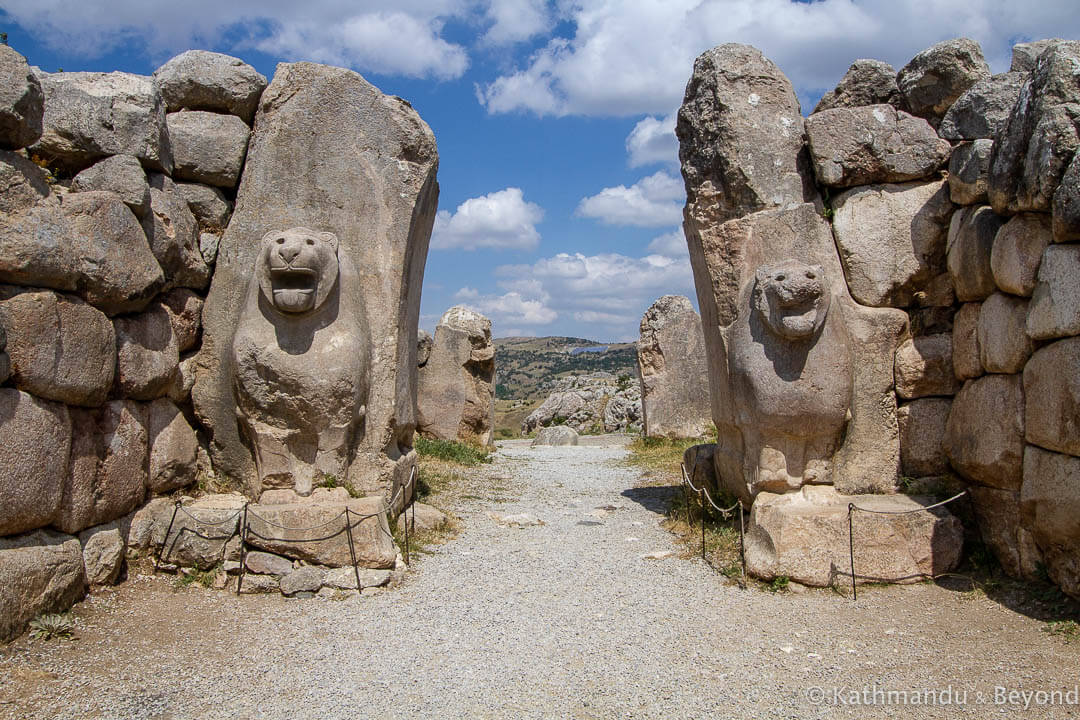
Lion Gate, Hattusa
Kayakoy
Kayakoy is an atmospheric ghost town with a tragic recent history. Approximately 8kms south of popular Fethiye, this hilltop settlement, which once comprised 4,000 or so houses and other buildings, used to have a Greek-majority population and was known by its Greek name of Livissi. During World War I, many Greek Orthodox Christians living in the Ottoman Empire were massacred and this included a high percentage of the 6,500 inhabitants living in Livissi. Those who did survive became refuges and mostly fled to Greece, leaving Livissi, and many other towns like it, more or less deserted.
Not long after the end of World War I, the Greco-Turkish War of 1919-1922 broke out. This resulted in the defeat of Greece and as part of the Treaty of Lausanne (1923), which followed thereafter, a population exchange between the two countries took place. But the agreement also included a caveat which perpetually barred Greek Orthodox refugees from returning to their homes in Turkey (*). This was the final nail in the coffin for the town that was eventually to be renamed Kayakoy and what’s left today is a picturesque set of ruins that have now been preserved as an open-air museum and historical monument that is under the protection of the Turkish government.
(*) In return, the majority of Turkish-speaking Muslims with Greek citizenship, with the exception of those living in Greek Thrace, were told to permanently leave Greece.
Not to be missed sights in and around Kayakoy
You have to pay a small fee to enter Kayakoy but, once inside you are free to scramble around and explore the dilapidated stone buildings at will. If there is anything to make a beeline for, it is the remains of the town’s two Orthodox churches and making your way up to the hilltop tower will reward you with some great views.
Kayakoy is located in the ancient province of Lycia and another thing we can recommend is walking the stretch of the Lycian Way that goes from Kayakoy down to the coast at Oludeniz (*).
(*) The Lycian Way is a marked long-distance walking trail that begins near Fethiye and ends approximately 20kms outside of Antalya. Large sections of its 500km length are along the coast and it is considered one of the world’s greatest, as well as most scenic, hiking trails.
The first part of this particular 8km section of the Lycian Way is hard work as you have to climb up and out of Kayakoy. But it then levels out and passes through shaded forest, which is greatly appreciated in the summer, for a decent section of the route. There are several viewpoints along this part of the trail that offer tantalising views of the coast and eventually, the path descends to the sandy beach at Oludeniz. From Oludeniz, there are regular dolmus heading to Fethiye.
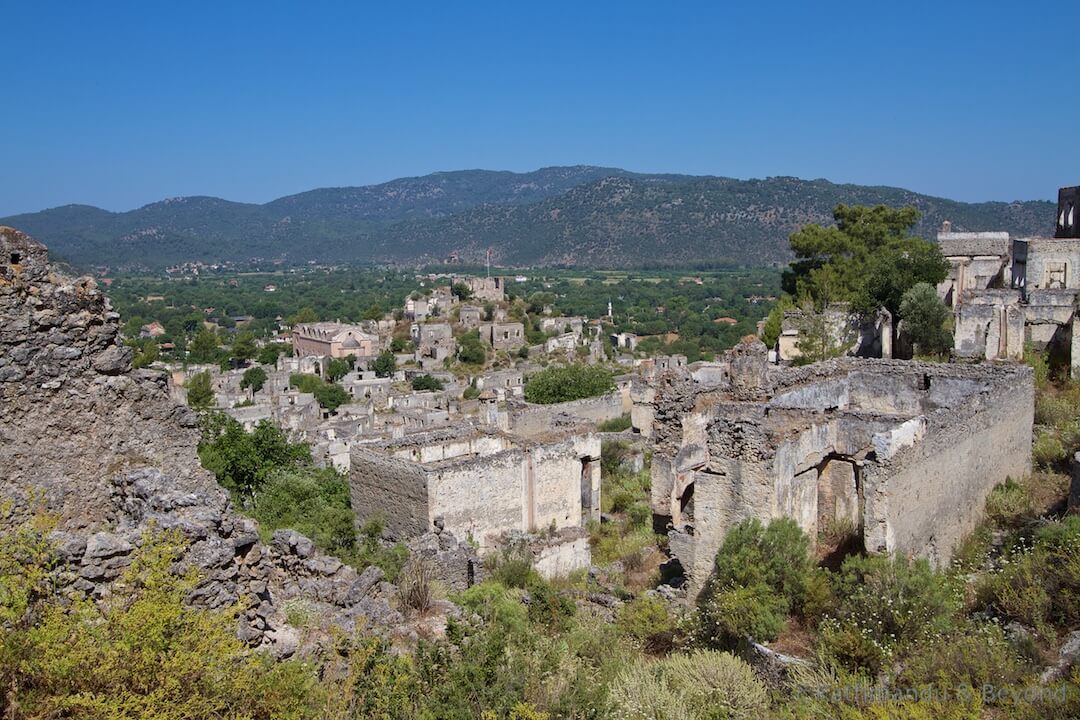
Kayakoy
Miletus
I could have picked any one of the classical ruins situated on, or near Turkey’s Aegean coast as one of the country’s must-see highlights: Assos, Priene, Letoon, Tlos, etc. They are all worth visiting as is mighty Ephesus which, despite the crowds, is an absolutely superb place to see. But, the one that really captured our imagination was the ancient Greek city of Miletus.
Located near the mouth of the Büyük Menderes River, which leads to the Aegean Sea, Miletus was once an important port and for a time, it was considered the mightiest and wealthiest city in ancient Greece. Anyone who is anyone in the classical world has had some association with Miletus. With origins spanning back to Neolithic times (3,500-3,000 BCE), the city first belonged to the Minoans before falling to the Mycenaeans. In 334 BCE, the Siege of Miletus placed the city in the hands of Alexander the Great. This was Miletus’s golden age and it flourished as a centre for trade as well for learning. In came the Egyptians for a short period, thereafter, before the Romans took control around 57 CE. It would be remiss not to mention the Byzantines, the Seljuks and the Ottomans, the last of which abandoned the city in the 15th century after its harbour eventually became silted and unusable. The ruins of Miletus now lie approximately 10kms inland from the sea.
Not to be missed sights in and around Miletus
The instant you arrive at Miletus it will be obvious what the main attraction is. Miletus has one of the greatest theatres we have ever seen. With an original capacity for 5,000 spectators, the auditorium was first built by the Greeks but later expanded by the Romans, who increased its capacity three-fold. Standing on the top tier and looking down puts its size into perspective and if, like us, you happen to have the entire site to yourself, it’s not a place you will forget in a hurry. There are other parts of the complex to explore such as the harbour and the remains of the Ionic Stoa (covered walkway), which is part sunken and covered with reedy wetland.
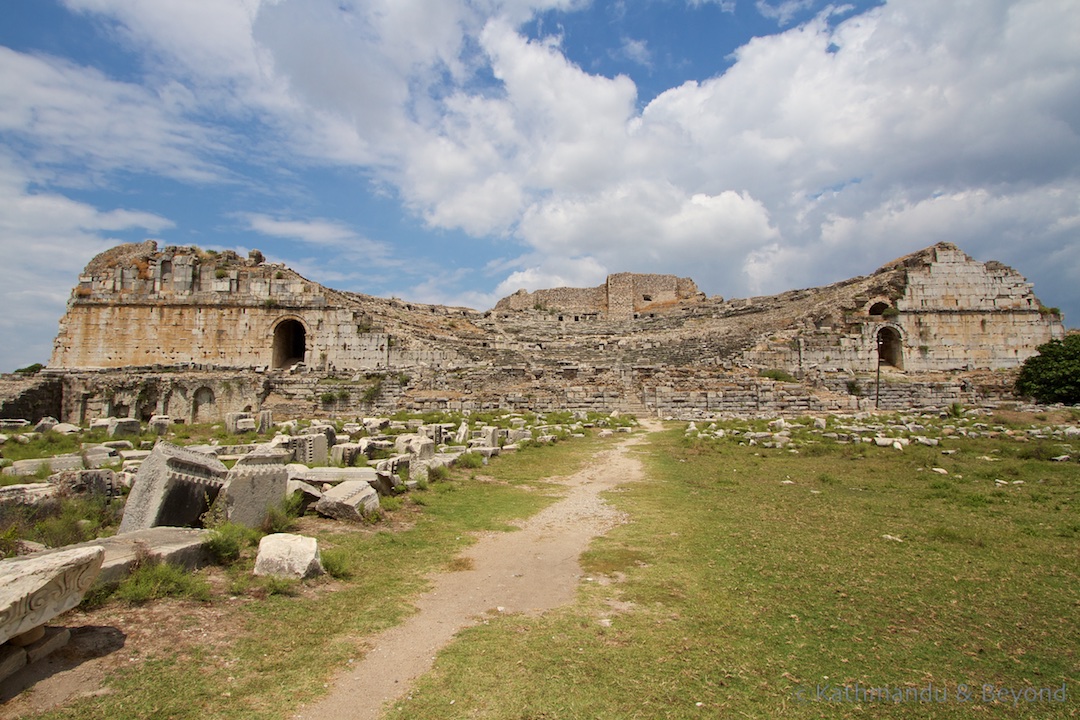
Grand Theatre, Miletus
Gelemis and Patara
If you taking your time travelling along Turkey’s wonderful coastline then Gelemis is a top-notch place in which to be based for a few days. Positioned in the country’s southwestern province of Antalya, more-or-less halfway between Fethiye and Kas, this laid-back village has plenty going for it. For starters, the beach at nearby Patara (2.5kms away) holds the title of being Turkey’s longest and most uninterrupted section of sandy shoreline. Not far from the entrance to the beach are the ruins of ancient Patara, plus there are other, more impressive, classical sites a short drive away. Gelemis has decent budget-friendly accommodation options, a handful of places to eat and is reasonably well-connected by public transport with other places along the coast, namely Fethiye, Kas and beyond to the city of Antalya.
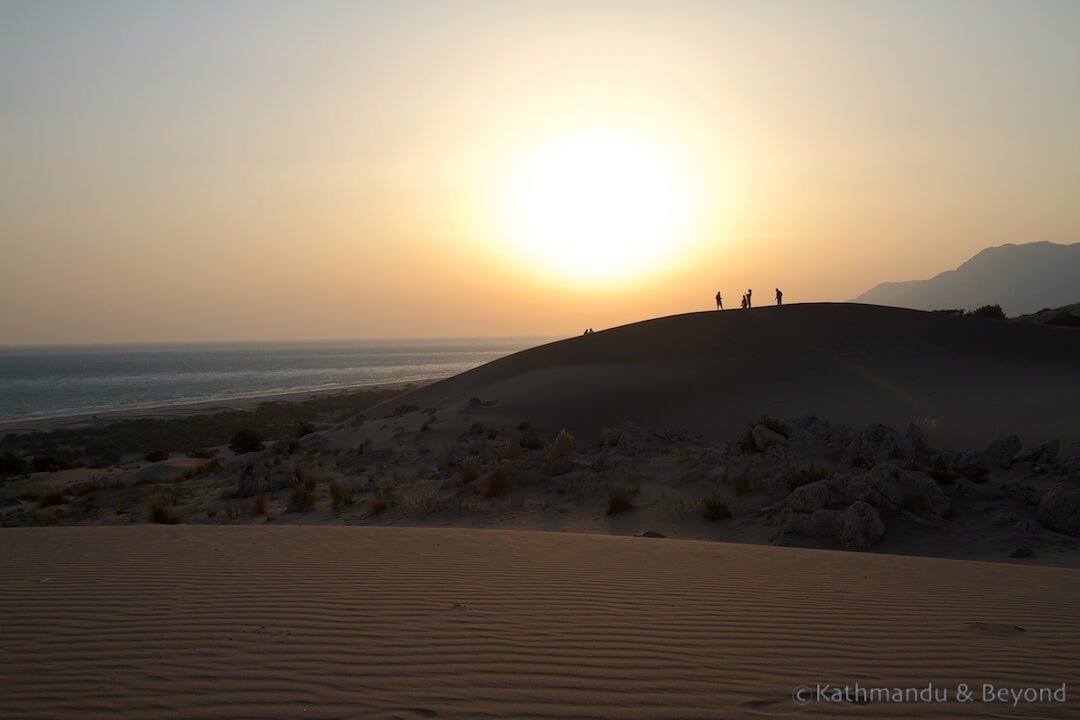
Patara
Not to be missed sights in and around Gelemis and Patara Beach
Patara Beach is gorgeous and, because of its size, finding a patch to call your own is a simple task. During the summer season, regular dolmus connect Gelemis with the beach but it is also a pleasurable walk as long as you avoid the hottest time of day in the height of the summer. There is some attractive countryside on either side of the road and stopping to see ancient Patara breaks up the journey. Like Miletus, classical Patara was once a prosperous port city, which was supposedly founded by Patarus, a son of Apollo – hence the name. Although ancient Patara isn’t as grand as some of the other ruins in the vicinity, it is nonetheless worth seeing, with the colonnaded street and the Arch of Modestus being the most interesting parts of the complex.
Heading to the large dunes behind the beach as the sun is about to go down will reward you with a sublime sunset.
If you are keen to see more ancient ruins, both Xanthos and Letoon are within striking distance of Gelemis.
Located on a rocky outcrop 10kms north of Gelemis, Xanthos was once at the centre of Lycian civilisation and is now a designated UNESCO World Heritage site. It shares this distinction with Letoon, which is 6kms away in a southwesterly direction. Letoon was a sanctuary of Leto, the Greek deity who was the lover of Zeus and supposed mother of Apollo and Artemis. Of all the smaller classical sites that we saw in this part of Turkey, I would say that Letoon was probably the nicest, although both of them are worth seeing if you get the chance.
Public transport options to the two places from Gelemis is limited. Xanthos can be reached by getting on any dolmus running between Fethiye and Kas and then walking for 1.5kms, but getting to Letoon would be very time-consuming. The best way to visit the two sites on the same trip is to hire a car or a taxi for the journey. We hired a car through the owners of the Patara View Point Hotel, which is where we stayed. We had a laid-back agreement and there was no paperwork involved. If you are not comfortable with this kind of arrangement then it would be better to hire the car in Fethiye or somewhere like that.
Before ending this section, Gelemis and Patara have one other thing going for them. Patara is part of the Lycian Way, which I touched on earlier in this post. This means you could arrive here by foot or, if you prefer, there are a couple of day walks that both start at Patara Aqueduct. One takes you inland and is about 10kms in length, while the other is a 12km coastal walk. As we haven’t done either, I’m not sure how you would get back to Patara/Gelemis but I’m sure if you ask locally then someone will know the answer.
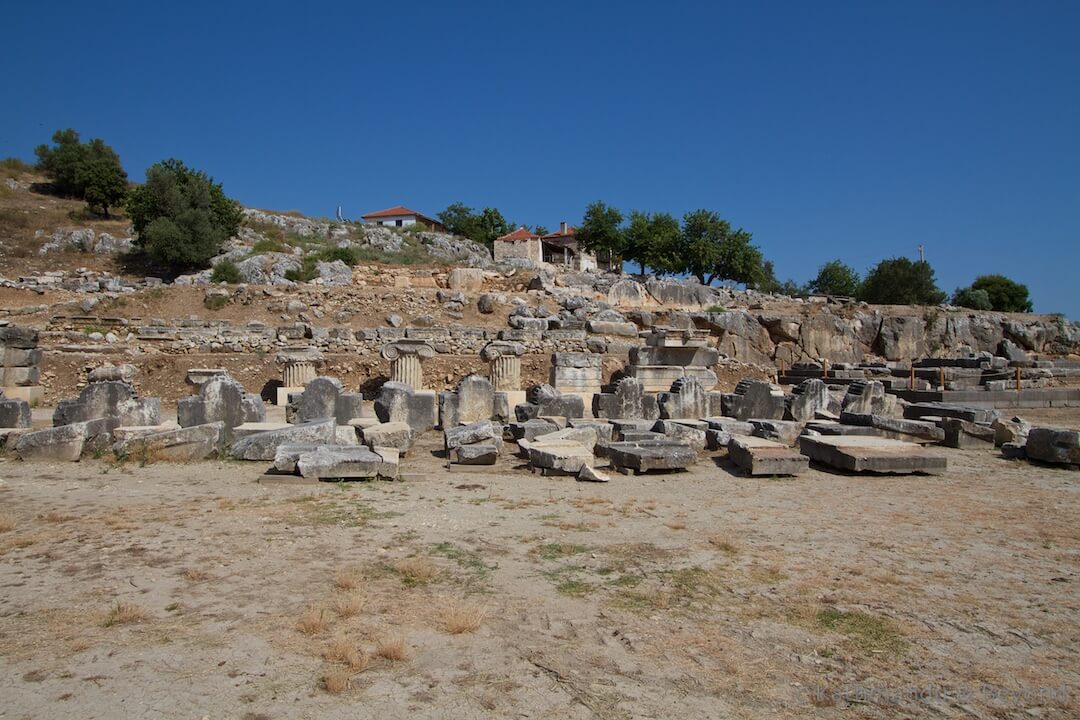
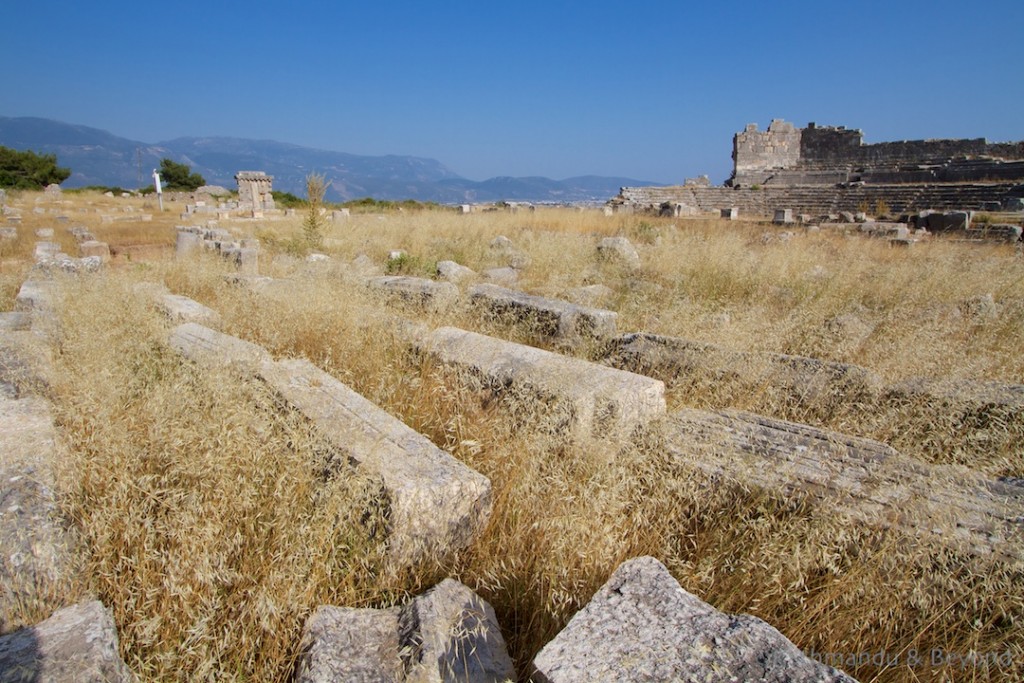
Letoon (right) and Xanthos (left)
And one place that should be here, but unfortunately, can no longer be included on a list of the best places to visit in Turkey …
Hasankeyf
When short-listing places in Turkey for this blog, I wanted to include Hasankeyf, a small town on the banks of the Tigris River in the south-east of the country.
Believed to be one of the oldest continuously inhabited settlements on the planet, I knew the town was in danger of being flooded because of a controversial plan to construct a hydroelectric dam nearby. But, what I didn’t realise until I started researching for this article was that it is too late and as of April 2020, the old city of Hasankeyf is now almost completely underwater. This is very sad news on many levels and not least for the town’s residents who have been uprooted and moved to the “new Hasankeyf”. We only stayed in Hasankeyf for one night back in the summer of 2015 but thoroughly enjoyed our time there, especially in the late afternoon when the light on honey-toned cliffs and what was left of the Tigris River was absolutely perfect.
For the purpose of posterity, here are a few photos of what Hasankeyf looked like before the dam project fully took hold.
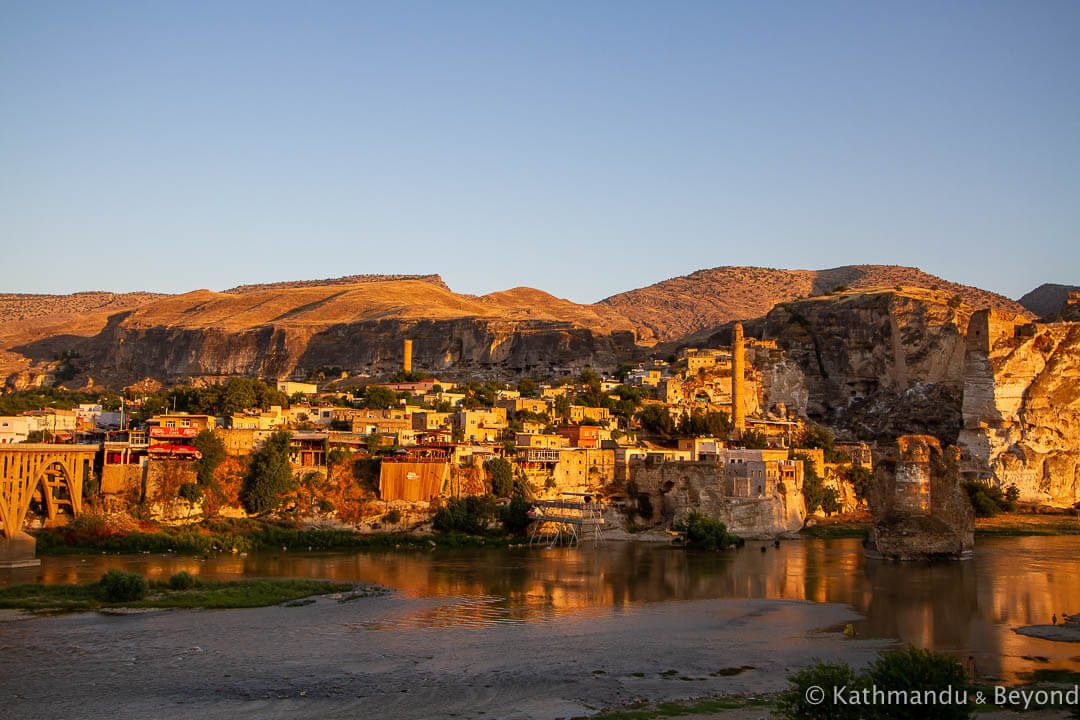
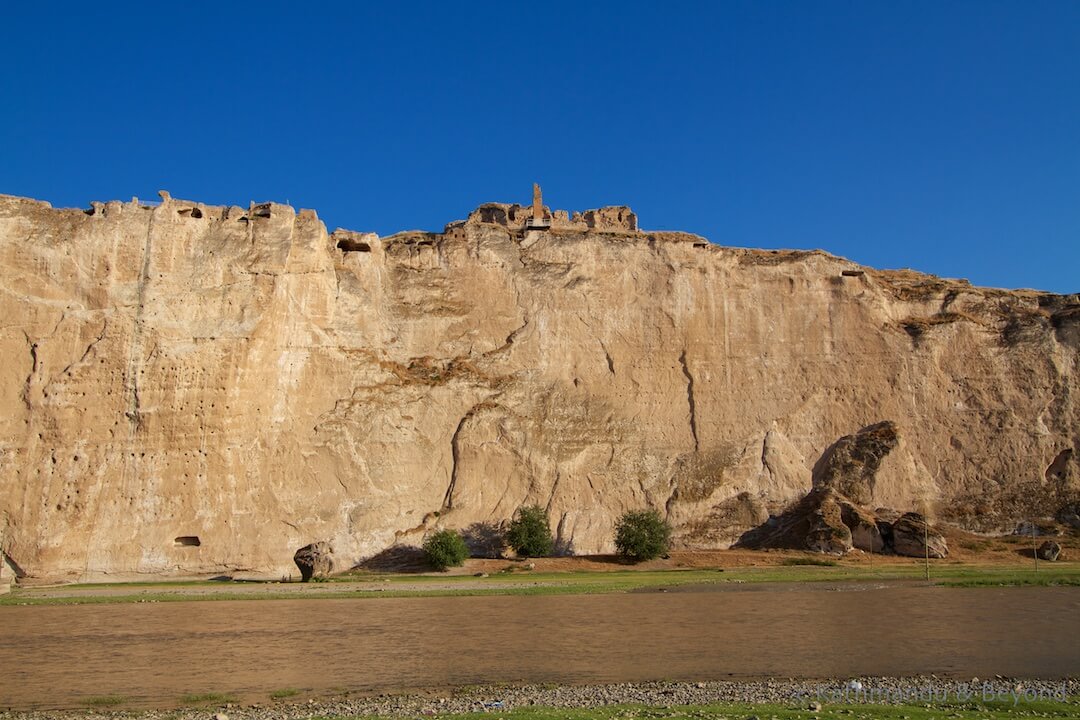
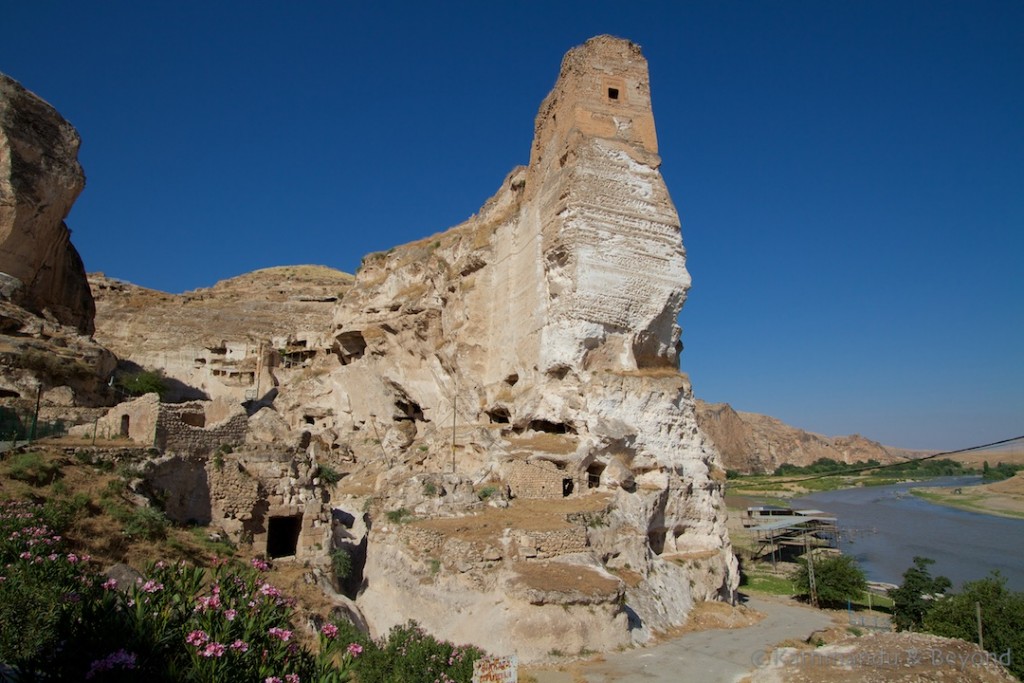
Hasankeyf
READ MORE BLOG POSTS ABOUT TURKEY
IF YOU FOUND OUR GUIDE TO THE BEST ALTERNATIVE PLACES TO VISIT IN TURKEY HELPFUL, PLEASE SHARE IT…
